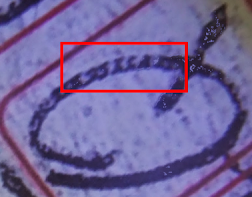VERSE 70 & THE CODE PAGE
VERSE 70: Or so it seems!
The image above is of the page that Ald Boxall produced to the police to view. He said it contained a verse, verse 70, from the book and the said book was given to him by Jo Harkness. So far so good?
Well, thanks to the new camera and another technique, we found that there is a lot more to this page than at first meets the eye, apart from microcode being found in each of the letters of each word, today I was able to uncover conclusive evidence of tradecraft/espionage and on this page.
And the point? Well, Alf was fully aware of the real nature of the handwritten Verse 70.
VERSE 70 LATEST PICS:
 |
| CLOSE UP JESTYN SIGNATURE |
In the above image, we have a close up of microcode hidden in the signature, whilst it is just visible in the stroke of the letter J, the highlighted inner box clearly shows a set of letters XAVER with X3208 beneath that set.
For this next image, first look again of the main signature image above, you can see what looks like the closing of inverted commas above and to the right of the JESTYN signature. The close-up image below reveals much more:
Sets of darker letters and numbers can be seen within and around the shape of the commas.
The last new image for Verse 70 is a close up of some of the writing:
From lines 2, 3 and 4, you can clearly see number and letter sets in the highlighted areas of the words and the dash. What I found interesting is that in the word beneath and to the left of the word 'then', in the crossbar stroke of the letter 't' there are in fact two lines of code and the same occurs in the last letter 'n'. As equipment and techniques improve, we will be able to show much clearer images but given the current situation, I think we have made great progress. Clive is joining the party as he has also acquired a new and similar camera!
Moving on now to the new code page images:
As you can see, gradually we are making improvements to the images that we produce of the code page, at the base or 'ribbon' of the code page you can make out numbers and letters along its length. In bith letters S, you can also see numbers and letters.
A different angle and more letters and numbers in the ribbon especially to the right.
Finally, a look at the dark stain to the top left of the code page:
This is by far the best image of the left 'stain' that we have managed, we have been able to lift the darker lettering from the less dark grey background. There is still some work to do but numbers and letters are visible. If you look at the upstroke of the letter M, you can just make out numbers and letters there as well.
I believe that the book given to Alf was used as some kind of training exercise in the field of clandestine communications.
It is entirely possible that Alf and Jo belonged to an organisation known as 'The Association', a national anti-communist organisation set up to defend Australia in the event of a communist-inspired uprising which was very much on the cards during these times.
The Association held meetings of small groups of volunteers, many of whom were ex or serving army officers and based in each State. The meetings discussed plans and provided training to its membership.
But what does the Code page tell us? Quite a lot, as mentioned in earlier posts, it is now obvious that the Police and Naval Intelligence were aware of the true contents of the code page, they knew about the microcode via the efforts of Captain Nave, RAN. Captain Nave at one time reported to Commander Long, Director of Naval Intelligence. We know that Commander Long was the NSW head of The Association and he would have had the ability to directly communicate with Captain Nave and of course, Colonel Wills, the South Australian head of The Association.
I have no doubt that these were extremely honourable men and whatever their involvement in the SM case, it would have been nothing that was against the best interests of Australia.
More images to follow as time permits.
The jigsaw is falling into place, we will be in a position to put forward an end picture in the near future.

























































